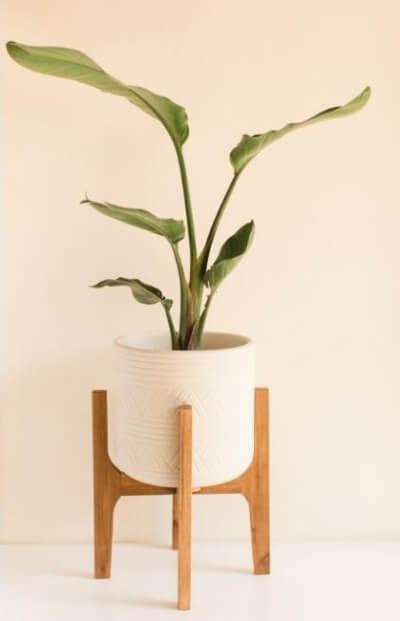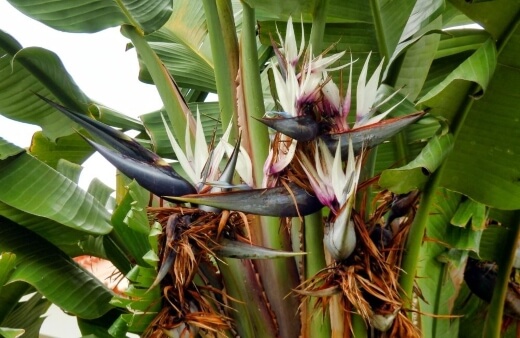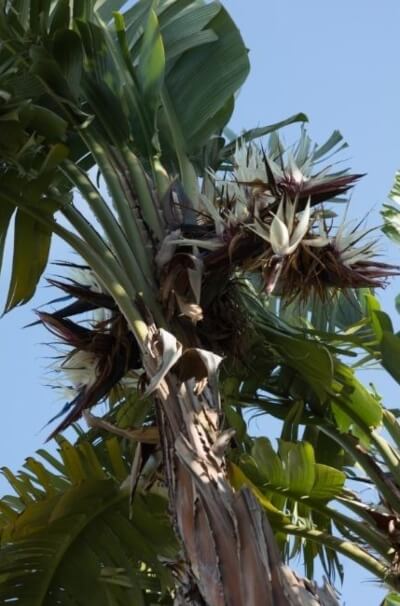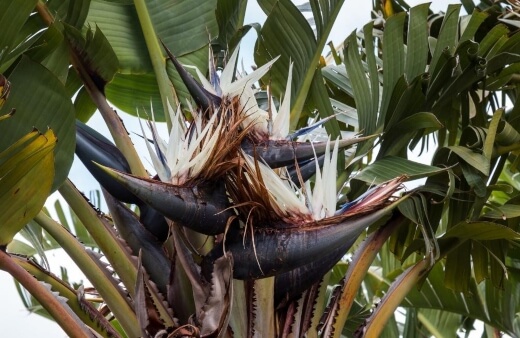Eye-catching and evergreen, the giant white bird of paradise plant is nothing short of spectacular. Although it doesn’t boast the same bright colours as its counterpart, the bird of paradise plant, Strelitzia nicolai or giant white bird of paradise is a large-growing garden plant with a sporadic flowering habit and massive white blooms.
Are you considering growing this gorgeous gargantuan? Follow our grow and care guide for everything you need to know to cultivate, care for and grow Strelitzia nicolai.
More...
Strelitzia nicolai Plant Details

The Strelitzia nicolai is part of the Strelitziaceae family, which includes tall-growing, large blooming evergreen plants, stemming from the coastal forests of Southern Africa.
Although the ever-popular, commonly seen bird of paradise plant is grown across the globe, few know about its paler, yet equally as striking as the giant white bird of paradise plant.
Sometimes referred to as the banana plant, the Strelitzia nicolai is a multi-stemmed tree, with large fan-like leaves and produces stunning, boat-shaped flower bracts with protruding white petals.
While this variety develops slightly darker leaves, it is still a fantastic choice for gardens. Of course, it’s also possible to grow this cultivar indoors. However, growers will have to sacrifice seeing blooms as they rarely flower indoors.
In the right environment, these plants can grow as much as 6 metres. Now, while it’s unlikely they’ll reach this height indoors, it’s still a good idea to ensure plenty of ceiling space if you’re wanting to keep them indoors.
How to Grow Strelitzia nicolai
The Strelitzia nicolai is known to be fairly adaptable, so when it comes to picking where to grow yours, you shouldn’t have too much concern. They’re happy with a wide range of light conditions, including direct sun or low light. Plus, they’ll need plenty of well-draining soil.

What Kind of Soil is Best for Birds of Paradise?
These plants don’t need much when it comes to soil. As long as it drains sufficiently, they’ll thrive in sandy, clay and loam soils (get to know more about loam soils here).
Even if growing in coastal areas, they’ll have no hassle establishing a strong root system in coarse sand soils making it perfect for coastal gardening.
If growing indoors or outdoors in a pot, be sure to pick a loose draining potting soil with a good level of perlite to improve soil texture.
Full Sun or Shade: What’s Better for the Giant White Bird of Paradise?
These plants adapt to a wide range of light. However, it is important to note that the more sunlight these plants have, the more they’ll flower. This is a key reason that they won’t flower indoors.
If growing in your garden, a spot with lots of morning sunlight is ideal. If indoors, situate your pot somewhere near a south-facing window which will give you the perfect level of light for a year-round, gorgeously green plant.
Propagating Giant White Bird of Paradise

These plants can be grown from seed or from the freely produced suckers which grow from the base of the plant. However, most gardeners opt for growing from suckers as it can be far quicker to see results.


Get Your Free Guide:
Master Growing Australian Natives eBook
A Must Have Complete Guide for Every Australian Garden
Get Your Free Guide:
Master Growing Australian Natives eBook
A Must Have Complete Guide for Every Australian Garden
Trying to grow a giant white bird of paradise from seed can take some time not only to establish but to begin flowers. Seeds can take anywhere between 3 to 5 years to germinate, so patience will be key.
If you’re looking for a quicker way to create happy little paradise plants, then suckers are the way to go. Suckers can be removed and re-planted during the spring or at a time re-planting.
Propagation from Suckers
- Locate suckers growing around the base of your plant. Suckers are rhizomes that protrude out of the base of the plant. These can be left to fill out your plant, or removed to create new plants.
- Using a sharp pair of shears or spade, remove the suckers from the parent plant.
- Dip suckers into a rooting hormone and plant into a fresh, rich potting mix.
- Keep your little plant in a warm, sunny spot and water well for the first few weeks.
Propagating from Seeds
- Seeds can be removed from parent plants. Simply locate the 3-lobed seed capsule and remove it from the plant.
- Sow seed into a rich, seeding mix and cover with a layer of compost.
- Keep the soil moist and leave your seedling in a semi-shaded spot to germinate.
- Germination can take some time so it’s best just to leave it be. Avoid moving the pot around too often.
Planting Giant Bird of Paradise

Once your young plant has started to develop new growth, you can get ready to plant. More so, plants that are grown in pots, should be re-planted every 3 years to replenish the soil and encourage new growth.
Here’s what you’ll need to do to plant your Strelitzia nicolai:
- Prepare your pot or planting site by mixing some topsoil or coconut coir into the soil.
- Dig a hole that will fit your root ball and plant.
- Take care to pat down the soil to secure the base of your plant.
- Keep young plants well-watered in the first few weeks after planting – while still allowing the soil to drain in between.
When picking your ideal planting site, try to avoid at least 1 metre away from pipes, walls and other structures. These plants have a vigorous root system that tends to creep after a few years.
If you’re growing yours in a pot, be sure to pick a pot with plenty of drainage holes which will not allow for the soil to get waterlogged. Drainage is an absolute must.
Strelitzia nicolai Care Guide
While establishing your Strelitzia nicolai may sound like a slight challenge, once established they’re an easy maintenance plant. Although they love moisture and humidity, they can handle periods without it.

Watering Giant Bird of Paradise
Figuring out your watering routine can be the trickiest part. Root rot can be a very common killer of these plants, so monitoring moisture levels is essential. Yet, they need a good level of moisture to thrive.
Water your plants regularly, while allowing the soil to dry out in between. If growing indoors, it’s advisable to mist more than water to supplement some much-needed moisture and humidity.
These plants can also be sensitive to salt build-up, as such it’s a good idea to use distilled or rainwater. Some growers recommend watering around the radius of the base of the plant.
This will help to avoid getting water into the folds of plants – which can begin to rot if left standing.
Fertilising Giant Strelitzia
During the growing season, these plants tend to feed a lot. This means that in less-than-optimal soils, they’re going to need quite the nutritional nudge from time to time.
Pick a well-balanced, liquid fertiliser to support your plants throughout spring and summer. Avoid fertilising in winter as this can have adverse effects.
Pruning Strelitzia nicolai
Pruning won’t be something you’ll have to do too often. However, cutting plants back a little during the winter can encourage new growth in the coming growing season.
Take care not to remove too much of the plant at a single time, leaving plenty of large leaves to spur on the growth. Dried out and dying leaves can also be removed throughout the year.
Be sure to use a clean and reliable pair of garden shears when pruning.
Giant Bird of Paradise Problems, Pests & Diseases

Pest and disease issues are not a very common concern for growers, especially when grown in the southern hemisphere. Still, when plants are in distress, either from over-watering or outside factors, they can be susceptible to common issues.
These include:
- Root rot
- Mealybugs
- Spider Mites
- Aphids
- Bacterial Wilt
- Scale
As a rule of thumb, just take care not to overwater your plants. Yellowing or wilting leaves are often the first sign that your plant is either getting too much or too little water.
If you cut back on watering, and the issue persists, consider re-planting to replenish the soil. When replanting, be sure to cut back any soggy damaged roots before planting.
Take the time to check on your foliage, should you notice a pest infestation, be sure to use a natural insecticide to protect your plants.

Bold, Bright & Brilliant – Start Growing Giant White Bird of Paradise today!
Whether you plan on growing it indoors, in a pot outside, along with entrances or as a pool plant – the giant white bird of paradise is guaranteed to pack an aesthetic punch.
There’s no denying that the Strelitzia nicolai is a gorgeous garden plant that will give you a wondrous spectacle when it blooms. Wherever you decide to grow your Strelitzia nicolai, keep a careful eye on watering and moisture to make sure you have a brilliantly blooming plant.
Published on February 13, 2022 by Maisie Blevins
Last Updated on September 19, 2025




